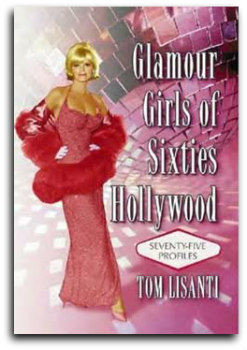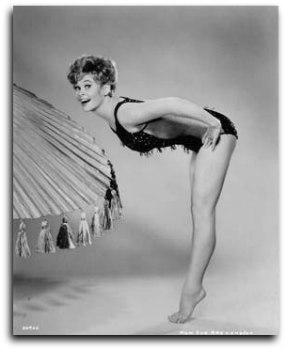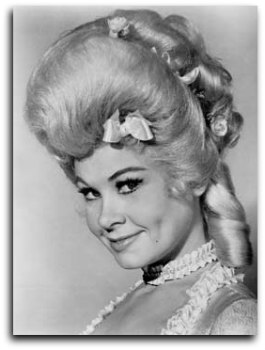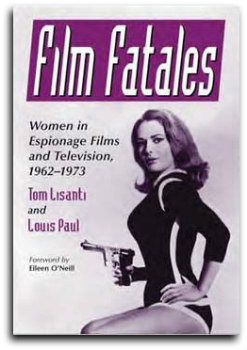
HOMEWesley Britton’s Books,
|
Spies on FilmSpies on Television & RadioSpies in History & LiteratureThe James Bond Files |
|
Spies on Television & Radio ~ A Spy Girl Recalls the
‘60s – An Interview with Actress Sue Ane
Langdon
By Tom Lisanti Editor’s Note ~  No one knows more about the sexy ladies of spy movies than author Tom Lisanti. For example, with collaborator Louis Paul, Tom wrote Film Fatales – Women in Espionage Films and Television, 1962-1973 (2002). With such a title, a reader might expect a glorified pin-up book in hard-cover, but Film Fatales is far more than that. The profiles and interviews in that collection offer insights and anecdotes that make this classic study a valuable and enjoyable reference book for experts and general readers alike. Likewise, his 2005 Hollywood Surf and Beach Movies earned high praise, becoming an official nominee by McFarland and Co for the Theatre Library Association’s 2006 Best Film Reference Book Award. Tom’s most recent title is Glamour Girls of Sixties Hollywood – Seventy-Five Profiles. For more information about this great new collection and his other books, check out Sixties Cinema. For Spywise Secret Dossier, Tom graciously chose one of his profiles from Film Fatales to share with spy buffs. He couldn’t have picked a better actress – Sue Ane Langdon covered all the bases in ‘60s pop culture. She worked with both Robert Vaughn and Robert Culp in The Man From U.N.C.L.E.. She worked with Robert Conrad on The Wild Wild West. Among her B-movie roles of the era, she was a spy girl in the cult favorite, A Man Called Dagger. If you like Sue’s anecdotes, there’s more stories like hers in Tom’s important contributions to TV and film studies. We hope you’ll look over his books you can order at his website or through the ads at the end of this article. Thanks, Tom, for sharing with Spywise Secret Dossier. Sue Ane Langdon 
Perky Sue Ane Langdon in a 1950s publicity photo. With curves galore to match her perky personality, Sue Ane Langdon (born on March 8, 1936 in New Jersey) played a variety of kooks and goofy dames throughout the sixties. After the death of her father when she was only two years old, Langdon’s mother, a former opera singer, began teaching voice lessons at local colleges around the country. After attending North Texas State and the University of Idaho, Langdon went to New York where she found work as a singer at Radio City Music Hall and was a performer on Broadway. She relocated to Hollywood in the late fifties and landed a recurring role as Kitty Marsh in the comedy series Bachelor Father in 1959. She left the show in 1961 and appeared on a number of TV shows including Surfside 6, 77 Sunset Strip, Perry Mason, Bonanza, The Andy Griffith Show, Gunsmoke and The Dick Van Dyke Show, among many others. Appearing on the cover of Life magazine led to a her short stint as Alice Kramden opposite Jackie Gleason on his variety series American Scene Magazine in 1962. Undaunted, Sue Ane Langdon returned to the small screen continuing to make guest appearances with the same amount of felicity. On the TV spy front, Langdon turned up in the fourth episode of The Man from U.N.C.L.E. entitled “The Shark Affair” (10/13/64) as the klutzy Elsa. Her husband, Harry Barnman (Herbert Anderson), is the latest craftsman to be abducted by a modern day pirate Captain Shark (Robert Culp), who is obsessed with the belief of imminent nuclear devastation. The show’s running gag is that she keeps slamming doors into helpful U.N.C.L.E. agent Illya Kuryakin (David McCallum). “I had met Robert Vaughn previously before doing this,” says Sue Ane Langdon. “He has the same atmosphere about himself as Napoleon Solo in the show – a very tongue-in-cheek polish and too, too suave! Bob Culp played the villain and didn’t hang around the set that much. He was not unfriendly but we didn’t have much opportunity to talk to each other. I also think he immersed himself in his character on and off screen. I saw him years later and he was much looser with a great sense of humor. That didn’t come out when we worked together.” In “The Night of the Steel Assassin” (1/17/66) on The Wild Wild West Langdon (in a change of pace role) brought an innocent sexiness to the role of Nina Gilbert, a prim young doctorate student whose uncle R.L. Gilbert (John Pickard) is murdered by an assassin nicknamed “Iron Man.” When Nina produces a photograph of eight officers in her uncle’s regiment during the Civil War, secret service agent James West (Robert Conrad) identifies President Grant as one of the two surviving men. Torres (John Dehner) is the other and Nina goes to warn him that his life is in danger, unaware that he is the killer. Torres hypnotizes Nina to “seize the day . . . and laugh.” Later West finds the scantily clad Nina working as a showgirl at the local saloon where she dances and whoops it up with the town’s cowboys. On the big screen, Sue Ane Langdon’s roles ranged from a fortuneteller lusting after Elvis Presley in Roustabout (1964), to an office secretary who can’t resist the charms of a carpet cleaner (Sean Connery) in A Fine Madness (1966), to an adulterous housewife in A Guide for the Married Man (1967). 
The charming Sue Ane Langdon in a still from Frankie and Johnny (1966). She even created quite a stir during the mid-sixties by baring her shapely derriere first at the close of The Rounders (1965) and then in the pages of Playboy. So it was not too surprising that she played a kooky bad girl in the spy film A Man Called Dagger (1967) directed by Richard Rush (whom Langdon describes as being “very nice. Considering the low budget, I think he did the best he could.”). Saddled with doing an accent, Langdon makes a sexy and duplicitous femme fatale. (Independent Film Journal commented that Langdon “plays with flair, employing a suspiciously Gabor-like accent.”) Her scenes begin when Paul Mantee as agent Dirk Dagger pretends to be an insurance investigator and pays a call to her health spa under the pretense of finding a missing Swedish girl. The self-centered Ingrid only wants to talk about her healthy regiment. She then asks, “Mr. Dagger, do you fence?” He doesn’t but accepts her challenge to try to get information out of her. She ends the match by ripping off her top and throwing it on Dagger’s sword prompting him to comment, “Touché.” After exercising and lunching where she reveals that she is a friend of meat packing tycoon Rudolph Koffman (Jan Murray), Ingrid seductively invites Dagger to join her in a nap, “You’ve become part of my daily routine, Mr. Dagger.” Dirk willingly obliges. Unbeknownst to them, they are spied on by Koffman. Later he congratulates Ingrid for feeding information to Dagger as he ordered but he slaps her for “taking three hours to tell him.” After the death of fellow agent Melissa, Dagger pays another visit to Ingrid who is taking a steam bath. He locks her in and keeps raising the temperature until she tells him how to get into Koffman’s office. Ingrid refuses but Dagger is insistent. She pleads for her life (“Dagger, please, please let me out. Dagger, I’ll do anything – anything.”). Ingrid finally gives him the information so Dagger turns on the cold water and dryly quips, “Just play it cool.” Being the owner of a health farm, the character of Ingrid was scantily clad throughout the film. Langdon is seen wearing a towel, a short fencing shirt, a halter-top with sweat pants, and nothing at all (to the audience’s imagination anyway) in a steam bath. “I don’t remember what I wore in that shower scene,” remarks Sue Ane Langdon. “Of course I had frosted glass in front of me but I can’t recall if I had anything on in back of there. But I do remember that fencing outfit. It was kind of pinned together. If you notice there is no opening on it. I don’t even remember who the costume designer was. I also did my own fencing. My husband Jack studied fencing in New York and he was hired to help with that scene. He coached Paul and I, but you really didn’t see us fence too much. He taught us the positions so I was doing it relatively legitimately.  Sue Ane Langdon also recalls that she remembers a couple of scenes that did not make it into the final print. “There was a scene on a massage table with my dog sitting beside me. My hair in this film was all different colors. The dog was a white West Highland Terrier and they used vegetable dye on it to match all the streaks in my hair. I did a promo tour for the film with my dog ‘of many colors.’ While in New York City people would walk up to me and say, ‘Oh, the poor thing,’ as if the colors were hurting her . . . for gosh sake, it washed right out! But you don’t see the dog much in the final version of the film. There was another shot of people hanging on meat hooks like Jan Murray was at the end. That didn’t make the final cut either. ” Not that Langdon felt any of these shots would have helped the film. The budget seemed to be the major hindrance. “That watch of Dagger’s did an awful lot of stuff. And the walls of the corridors of the meatpacking plant where made of tinfoil on pieces of plywood frame. It was obvious that the walls weren’t very thick or heavy. All expense was spared on this epic! I think if we could have had a little better direction or a little better budget or a little better script any of that might have helped the film. I recently ran into Eileen O’Neill at an autograph convention and she told me that A Man Called Dagger has built up a cult following. I was taken aback, but I am glad the fans are enjoying the film!” The seventies found Sue Ane Langdon concentrating on television over film. The sixties sexpot morphed into a dutiful housewife in the sitcom Arnie beginning in 1970, and she won a Golden Globe Award as “Best Supporting Actress in a Series” for her performance. After the show was cancelled in 1972, Langdon could be seen in a number of TV movies and in guest stints on such series as Love, American Style, Police Story and Banacek. She was also a regular on the series Grandpa Goes to Washington during the 1978-79 season. Her last film appearance was playing Weird Al Yankovic’s aunt in the comedy UHF (1989). Married since the mid-sixties, Langdon is still active in the Hollywood community. She makes the occasional appearance at conventions and film festivals where she is always warmly welcomed. Other films include – Strangers When We Meet (1960), The Great Imposter (1961), The New Interns (1964), When the Boys Meet the Girls (1965), Frankie and Johnny (1966), The Cheyenne Social Club (1970), The Evictors (1979), Without Warning (1980), Zapped! (1982), The Vals (1985), Hawkin’s Breed (1987) and Zapped Again (1989). Photographs courtesy of Lee Pfeiffer of Cinema Retro. Tom Lisanti’s books, including Girls of Sixties Hollywood – Seventy-Five Profiles, are available in bookstores everywhere, as well as these online merchants ~
Powell’s Books
|